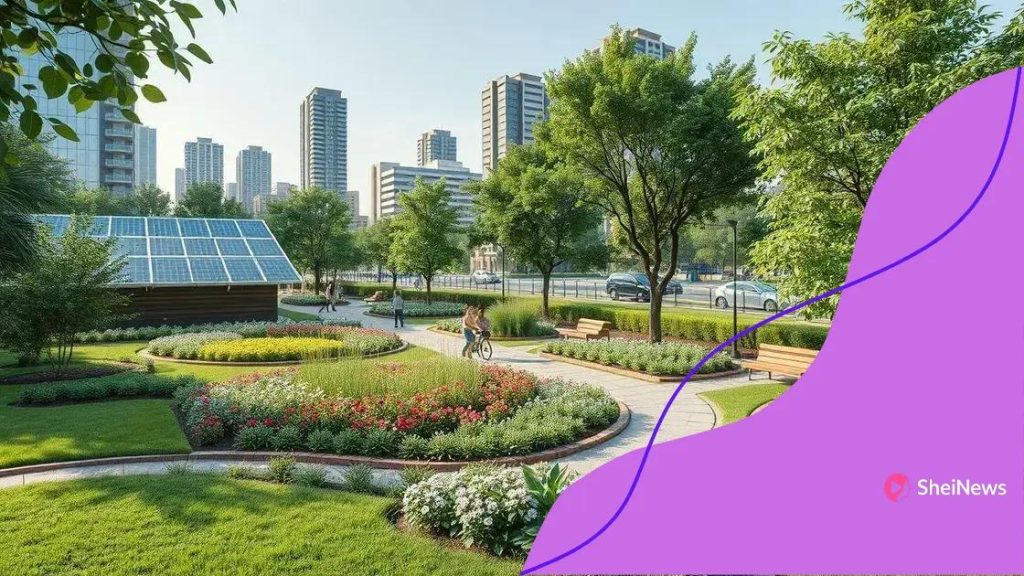Investments in green infrastructure: a priority for the future

Anúncios
Investments in green infrastructure enhance sustainability by improving air quality, reducing flooding, increasing property values, and promoting community wellness through the integration of natural and urban environments.
Investments in green infrastructure are gaining momentum as communities strive for sustainability. Have you considered how these investments could transform your environment and quality of life? This article delves into the impact and importance of green initiatives.
Anúncios
Understanding green infrastructure and its significance
Understanding green infrastructure is essential for shaping sustainable cities and communities. It refers to systems that use natural processes to manage water, filter air, and support biodiversity. This innovative approach contrasts sharply with traditional infrastructure methods, focusing on environmental harmony.
Key Components of Green Infrastructure
Several elements come together to create effective green infrastructure. These include:
- Green roofs: Vegetative layers that reduce heat and manage stormwater.
- Permeable pavements: Surfaces that allow water to filter through, reducing runoff.
- Rain gardens: Landscaped areas designed to soak up rainwater, providing habitats for wildlife.
- Wetlands: Natural areas that filter pollutants and provide vital ecosystems.
Each of these components plays a significant role in enhancing the urban ecosystem. By integrating them into city planning, we can address common problems like flooding and pollution. Moreover, these installations help create beautiful public spaces that improve the quality of life for residents.
Anúncios
Stormwater management is another critical aspect of green infrastructure. By utilizing nature-based solutions, cities can effectively reduce flooding risks while replenishing groundwater supplies. This approach fosters resilience against climate change, making urban areas better equipped to face extreme weather.
Benefits of Green Infrastructure
The advantages of investing in green infrastructure go far beyond aesthetic appeal. Some notable benefits include:
- Improved air quality: Plants absorb harmful pollutants, ensuring cleaner air.
- Enhanced biodiversity: Green spaces provide habitats for various species.
- Energy savings: Green roofs and walls help regulate building temperatures, lowering energy costs.
Additionally, green infrastructure promotes community well-being. It encourages social interaction and creates inviting environments for recreation. By integrating these features, cities can cultivate a sense of community and belonging among residents.
Challenges of Implementing Green Infrastructure
Despite its many benefits, implementing green infrastructure comes with challenges. Some urban planners may struggle with high upfront costs or limited space. However, understanding these obstacles is the first step to overcoming them. Collaborative efforts, community engagement, and innovative financing can help pave the way for successful projects.
Ultimately, embracing green infrastructure presents a vital opportunity for improving urban living. By recognizing its importance, we can collectively work towards creating more sustainable and resilient communities. The need for environmentally friendly solutions is more pressing than ever, and green infrastructure stands at the forefront of this movement.
Key benefits of investing in green infrastructure
Investing in green infrastructure offers numerous advantages for urban communities. These investments not only enhance the environment but also provide social and economic benefits. Understanding these key benefits is essential for promoting sustainable development.
Environmental Benefits
One of the most significant aspects of green infrastructure is its positive impact on the environment. It helps to improve overall ecosystem health, which is crucial in today’s urban landscapes. Implementing green practices allows cities to:
- Reduce urban heat: Greenspaces lower temperatures during hot months.
- Improve water quality: Plants and soils filter pollutants from runoff.
- Support biodiversity: Green areas provide habitats for wildlife.
By incorporating these elements, cities can work towards healthier ecosystems and mitigate the effects of urbanization.
Economic Benefits
In addition to environmental improvements, investing in green infrastructure presents economic opportunities as well. Cities can experience considerable cost savings from these investments. For example, by managing stormwater effectively, cities can minimize flooding costs and reduce infrastructure maintenance expenses.
Moreover, green infrastructure can enhance property values. Well-designed parks and green spaces attract residents and businesses, boosting local economies. This investment helps create sustainable jobs in sectors such as landscaping, construction, and maintenance.
Social Advantages
The social effects of green infrastructure are equally important. Green spaces foster community engagement and encourage active lifestyles. Parks, gardens, and open areas serve as gathering spots where people can interact and socialize.
These spaces also contribute to mental well-being. Research shows that access to nature positively impacts mental health, reducing stress levels and improving overall happiness. By investing in green infrastructure, communities become more livable and enjoyable.
Furthermore, promoting sustainability through these investments can lead to greater public support for environmental initiatives. As citizens recognize the benefits of green infrastructure, they are more likely to engage in community programs and advocacy.
Successful case studies in green infrastructure investments

Exploring successful case studies in green infrastructure investments reveals how cities worldwide are effectively addressing environmental challenges. These examples highlight innovative solutions that promote sustainability and social welfare.
New York City’s Green Infrastructure Program
New York City is a leader in implementing green infrastructure. The city’s Green Infrastructure Program focuses on managing stormwater runoff. By creating absorbent areas like green roofs and permeable pavements, NYC has significantly reduced the volume of stormwater entering the sewer system. This investment not only mitigates flooding but also enhances urban greenery.
Portland’s Ecoroofs
Portland, Oregon, has successfully integrated ecoroofs into its urban landscape. These green roofs reduce heat and provide insulation. They also help filter pollutants and manage rainwater. The city offers incentives for builders to install ecoroofs, showing a strong commitment to sustainable development.
- Over 800 ecoroofs exist across the city.
- These roofs reduce stormwater runoff by over 75%.
- They improve building energy efficiency.
Such initiatives contribute to improved air quality and energy savings, making Portland a model for green infrastructure.
Chicago’s Green Alley Program
Chicago has implemented its Green Alley Program, aiming to transform traditional alleys into green spaces. By installing permeable paving and adding green elements like trees and plants, these alleys reduce runoff and enhance neighborhood aesthetics. This program improves not only environmental conditions but also community interaction.
The green alleys collect and manage stormwater more effectively, ensuring cleaner streets and healthier ecosystems. Also, they foster a sense of pride among residents, making communities feel more inviting.
San Francisco’s Urban Tree Canopy
San Francisco has focused heavily on expanding its urban tree canopy. Trees play a vital role in improving air quality and providing shade. The city’s commitment to planting and maintaining trees helps combat the urban heat island effect. This program has led to planting thousands of trees, enhancing the community’s green spaces.
In addition, these trees provide numerous benefits, such as energy savings, increased property values, and improved mental health for residents enjoying these green environments. Case studies like these underline the importance and potential of investing in green infrastructure.
Navigating challenges in green infrastructure projects
Navigating the challenges in green infrastructure projects is crucial for ensuring their success. While these initiatives offer many benefits, they also face obstacles that can hinder progress. Understanding these challenges allows cities to devise effective solutions.
Funding and Budget Constraints
One of the most significant hurdles is securing adequate funding. Green infrastructure projects often require upfront investments that can be substantial. Many cities struggle to allocate budgets for these initiatives, especially during economic downturns. To overcome this, cities can explore various funding sources.
- Grants: Many federal and state programs offer grants for sustainable development.
- Public-private partnerships: Collaborations between governments and private businesses can provide additional resources.
- Green bonds: Issuing bonds to fund environmental projects can attract investors.
Using these financing options helps to ensure that green infrastructure projects receive the necessary support.
Regulatory and Policy Challenges
Another challenge involves navigating complex regulatory environments. Many municipalities have various laws and regulations that can slow down or complicate the approval process for green projects. Awkward permitting processes may lead to delays, frustrating project managers. To tackle this issue, cities can work to streamline regulations and develop clear guidelines that support green initiatives.
Engaging with stakeholders early in the process helps build necessary support. Furthermore, educating local governments about the importance of green infrastructure can create a more favorable policy environment.
Community Engagement and Awareness
Community involvement is vital for the success of green infrastructure projects. However, local residents may be unaware of the benefits these initiatives bring. This lack of awareness can lead to resistance or opposition. Addressing this issue requires effective communication and engagement strategies.
Organizing informational meetings and workshops allows community members to learn about the benefits of green infrastructure. Encouraging participation in planning and decision-making fosters a sense of ownership among residents. Involving citizens in the development process ensures that projects meet community needs and gain support.
Maintenance and Long-term Sustainability
Once green infrastructure projects are implemented, maintaining them presents another challenge. Continual care is essential for their functionality and effectiveness. However, many cities face challenges in securing ongoing funding for maintenance activities. To address this issue, cities should consider incorporating maintenance costs into the initial project budget and establish dedicated funds for upkeep.
Additionally, training local personnel to manage these projects can foster sustainability. Engaging community members in maintenance efforts encourages long-term investment in green infrastructure. By addressing these challenges, cities can pave the way for successful implementation of green infrastructure initiatives.
Future trends in green infrastructure investment
The future trends in green infrastructure investment show promising shifts towards sustainability and resilience in urban planning. As cities face the realities of climate change, investments in green infrastructure are becoming increasingly important.
Increased Public Awareness and Demand
Public awareness regarding environmental issues is growing. This has led to an increased demand for green infrastructure. Citizens now recognize the value of parks, green roofs, and permeable pavements. They understand how these projects can enhance their quality of life. As a result, communities are advocating for local governments to invest in more green spaces.
Technological Innovations
Advancements in technology are also shaping the future of green infrastructure. Smart technologies help monitor and manage urban ecosystems. For instance, sensors can track rainfall, soil moisture, and vegetation health. This data allows cities to optimize the management of green spaces.
Additionally, innovative materials are being developed for use in green infrastructure projects, such as eco-friendly pavements that reduce heat and absorb rainfall. These inventions enhance the functionality of green spaces while minimizing environmental impact.
Integrated Approaches to Urban Planning
Integrating green infrastructure with other urban planning strategies is gaining traction. A holistic approach combines green practices with traditional infrastructure. For example, cities are designing transportation systems that incorporate green corridors. This not only improves connectivity but also enhances biodiversity.
By considering green infrastructure early in the planning process, cities can create more sustainable and efficient urban environments. This trend is essential for tackling challenges like urban heat islands and stormwater management.
Investment in Climate Resilience
As climate-related disasters become more common, investing in climate resilience is a top priority. Cities are recognizing the need for infrastructure that can withstand extreme weather. Green infrastructure offers vital solutions, like absorbing excess rainwater during floods and providing shade during heatwaves.
Governments and organizations are increasingly looking at green infrastructure investments as an effective way to protect communities. This focus on resilience will likely increase funding and support for green initiatives.
Funding Opportunities and Collaborative Models
The future of green infrastructure investment will also see an emergence of various funding opportunities. Governments are beginning to establish dedicated funding for green projects. Public-private partnerships are becoming more common, allowing cities to leverage private investments to enhance their infrastructure.
Innovative financing models, like impact investing and crowd funding, are also making their way into green infrastructure. This diversification of funding sources will help cities overcome budget constraints, ensuring more projects can be developed and maintained.
FAQ – Frequently Asked Questions about Green Infrastructure Investment
What are the main benefits of investing in green infrastructure?
Investing in green infrastructure offers environmental benefits, such as improved air quality and reduced flooding, along with economic gains like increased property values and energy savings.
How can technology improve green infrastructure projects?
Technology enhances monitoring and management of green infrastructure, utilizing smart sensors to track conditions and optimize maintenance.
What challenges do cities face when implementing green infrastructure?
Cities often struggle with funding, regulatory hurdles, and community engagement when trying to implement green infrastructure projects.
What are some future trends in green infrastructure investment?
Future trends include increased public awareness, technological innovations, and integrated urban planning, along with diverse funding sources to support green initiatives.





